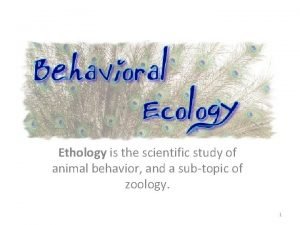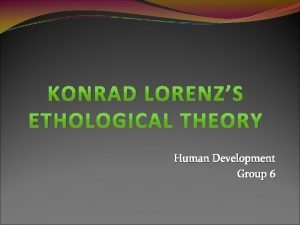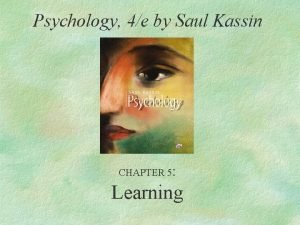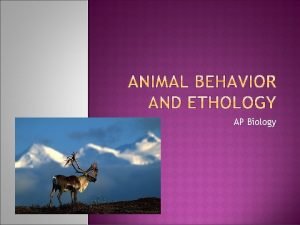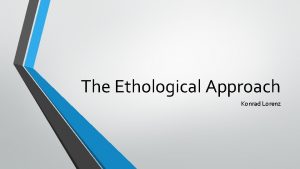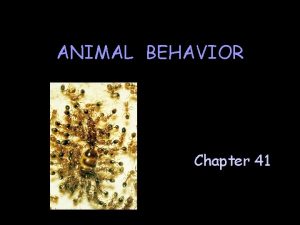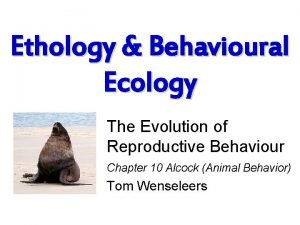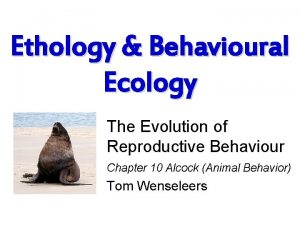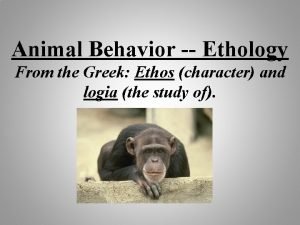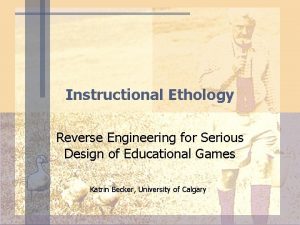A 6 Ethology Understandings Ethology is the study












- Slides: 12

A. 6 Ethology

Understandings Ethology is the study of animal behavior in natural conditions Natural selection can change the frequency of observed animal behavior Behavior that increases the chances of survival and reproduction will become more prevalent in a population Learned behavior can spread through a population or be lost from it more rapidly than innate behavior Application Migratory behavior in blackcaps as an example of the genetic basis of behavior and its change by natural selection Blood sharing in vampire bats as an example of the development of altruistic behavior by natural selection Foraging behavior of shore crabs as an example of increasing chances of survival by optimal prey choice Breeding strategies in coho salmon populations as an example of behavior affecting chances of survival and reproduction Courtship in birds of paradise as an example of mate selection Synchronizes oestrus in female lions in a pride as an example of innate behavior that increases the chances of survival and reproduction Feeding on cream from milk bottles by blue tits as an example of the development and loss of learned behavior

Ethology vs Psychology Ethology study of animal behavior in natural conditions Psychologists experimental, laboratory approach which controls the animals environment ‘A psychologist put the animals in a box and watches them from the outside; an ethologist put himself or herself in a box and looks out at the animals

Natural Selection Survival determined by species surroundings and compatibility of their characteristics with those surroundings Behavior complicated series of responses to environment Change behavior as response to change in environment Change can be extreme speciation Peppered Moths light and dark depending on the tree they reside on genetic trait Variations in genetic traits, lead to variations in behavior, lead to survival due to natural selection

Small warblers – migrate between Spain and Germany Breed in Germany (spring/summer), spend winter in Spain Change? Blackcaps migrating to UK instead Return migration 10 days earlier than Spain Blackcaps Early return more territory choice more eggs

Genetic basis? Eggs collected from UK and Spain Blackcaps Young reared, migration monitored (not guided by parents) All birds tended to migrate in same direction as parents Interbred two groups birds flew in between routes Supports hypothesis: Blackcaps genetically programmed to fly a certain direction Environmental Benefit? Winter bird gardens in UK for feeding Change in migration, could lead to speciation Result from changes in courtship due to earlier arrival at breeding grounds

Altruistic behavior Benefits others at cost to oneself Kin selection Helping relatives – increase change that donors genes are passed along Reciprocal Not relatives – individuals on equal basis share resources with each other Blood sharing in vampire bats More likely to share with other whom have shared Female bats regurgitate blood to their long-term associates significantly increases chances of survival “sharing” genes are more likely to be inherited

Foraging behavior in shore crabs Prefer to forage mid-sized mussels over larger mussels Cost – benefit ratio Larger mussels provide more food crack/chip claws Mid-size provide enough food claws kept in-tact Mating – male crabs fight – undamaged claws lead to reproductive success

Breeding strategies in coho salmon Spawn up to 1 year earlier More offspring produced Short maturation time gene inherited More successful 75% mated 58% mates

Courtship in the bird of paradise Sexual Selection Males: Females looking for more vigor and fitness Extremely color, plumage, fancy behavior Health related to look – attract females Behavioral oddities: Puffing up chest, flaring feathers, dancing As one type of courtship behavior becomes prevalent more successful behavior inherited

Synchronized oestrus in lions Innate behavior New male lion enters a female pride Kill or chase out all cubs Within two weeks – all females move into oestrus Female lions rear young and hunt for pride All females rear all young to improve survival If variety of ages existed: bullying could occur, hunger, harm If cubs all same age – well protected by females If cubs survive to sexual maturity genes get passed on Period of sexual receptiveness

Blue tits and learning and forgetting Milk used to separate into cream on top and milk below Blue tits and European Robins would drink cream Put lids on milk Blue tits able to pull foil lid off of milk, Robins did not Blue tits are flocks – learning spread through social communication Robins are solitary birds – no advantage needed Learned skill has been lost: Style of milk (homogenized) Style of container (plastic lids) Delivery method (store bought)
 Releasing stimulus
Releasing stimulus Lorenz ethological theory
Lorenz ethological theory Ethology
Ethology Explain two contrasting understandings of salah
Explain two contrasting understandings of salah Examples of enduring understandings
Examples of enduring understandings Essential understanding meaning
Essential understanding meaning Tư thế ngồi viết
Tư thế ngồi viết Gấu đi như thế nào
Gấu đi như thế nào Thẻ vin
Thẻ vin Ví dụ giọng cùng tên
Ví dụ giọng cùng tên Thơ thất ngôn tứ tuyệt đường luật
Thơ thất ngôn tứ tuyệt đường luật Các châu lục và đại dương trên thế giới
Các châu lục và đại dương trên thế giới Từ ngữ thể hiện lòng nhân hậu
Từ ngữ thể hiện lòng nhân hậu
